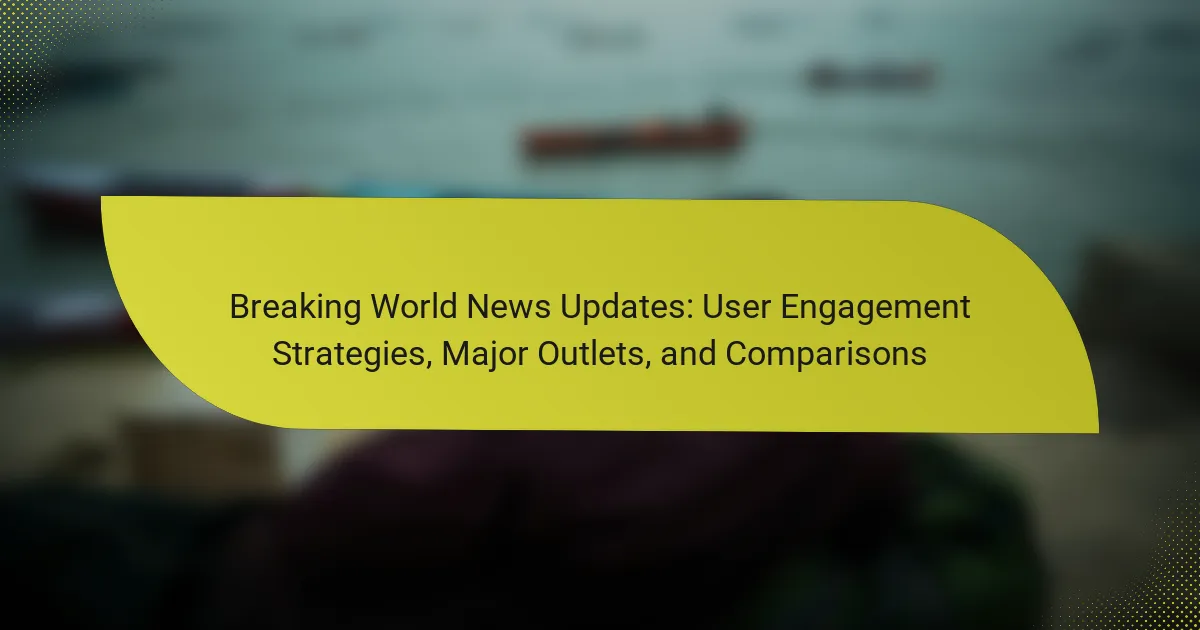In today’s fast-paced information landscape, news outlets in the US are increasingly focusing on user engagement through interactive and personalized strategies. By leveraging real-time updates and social media, these platforms aim to create a more dynamic news experience that resonates with diverse audiences. Understanding the differences in engagement methods among major news outlets can empower users to select the most relevant sources for their news needs.

How can news outlets improve user engagement in the US?
News outlets in the US can enhance user engagement by adopting interactive and personalized strategies that cater to audience preferences. By focusing on real-time updates and leveraging social media, they can create a more dynamic and engaging news experience.
Interactive content strategies
Interactive content, such as polls, quizzes, and live Q&A sessions, encourages users to participate actively rather than passively consuming news. This approach can increase time spent on the site and foster a sense of community among readers.
For example, news outlets can host live discussions on current events, allowing users to submit questions and comments in real-time. This not only engages the audience but also provides valuable insights into their interests and concerns.
Real-time updates and alerts
Providing real-time updates and alerts keeps users informed about breaking news as it happens. This can be achieved through push notifications via mobile apps or alerts on websites, ensuring that users receive timely information on critical events.
News outlets should consider allowing users to customize their alert preferences based on topics of interest, such as politics, sports, or local news. This personalization can significantly enhance user engagement by delivering relevant content directly to their devices.
Social media integration
Integrating social media platforms into news outlets can significantly boost user engagement. By sharing articles and updates on platforms like Twitter, Facebook, and Instagram, news organizations can reach a broader audience and encourage sharing among users.
Additionally, enabling users to comment and share articles directly from the news site can create a seamless experience, encouraging discussions and interactions that keep readers coming back for more.
Personalized news feeds
Personalized news feeds tailor content to individual user preferences, enhancing engagement by ensuring that readers see news that matters to them. Algorithms can analyze user behavior to recommend articles based on past reading habits and interests.
News outlets should implement user-friendly options for readers to select their preferred topics, allowing for a more customized experience that can lead to increased loyalty and time spent on the site.
Community engagement initiatives
Community engagement initiatives, such as local events, forums, and partnerships with local organizations, can strengthen the connection between news outlets and their audiences. These initiatives foster a sense of belonging and encourage users to interact with both the news and each other.
For instance, hosting town hall meetings or community discussions on pressing local issues can provide a platform for dialogue and feedback, making readers feel more invested in the news they consume.

What are the major news outlets in the US?
The major news outlets in the US include a mix of traditional newspapers, television networks, and online platforms that provide comprehensive news coverage. These outlets are known for their influence, reach, and ability to shape public opinion on various issues.
The New York Times
The New York Times is a leading American newspaper renowned for its in-depth reporting and analysis. It covers a wide range of topics, including politics, culture, and international news, often setting the agenda for other media outlets.
With a strong digital presence, The New York Times offers subscription-based access to its articles, providing a mix of free and premium content. Readers can expect high-quality journalism, but subscriptions can be relatively costly compared to other sources.
CNN
CNN is a major cable news network that provides 24-hour news coverage, focusing on breaking news and live events. It is known for its global reach and extensive reporting on political developments, social issues, and international affairs.
As a pioneer in the 24-hour news cycle, CNN emphasizes real-time updates and live reporting. However, viewers should be aware of the network’s editorial slant, which can influence the presentation of news stories.
BBC News
BBC News, while based in the UK, has a significant presence in the US market, offering international news coverage with a global perspective. It is known for its impartial reporting and comprehensive analysis of world events.
BBC News is accessible online and through various platforms, providing free content to a broad audience. Its reputation for reliability makes it a trusted source for many American viewers seeking unbiased information.
Reuters
Reuters is a global news organization that specializes in financial and business news, but it also covers a wide array of topics, including politics and technology. It is known for its fast and accurate reporting, making it a go-to source for professionals and businesses.
Reuters operates on a subscription model for its in-depth reports, but it also offers free news articles online. Its emphasis on factual reporting and neutrality appeals to those looking for straightforward news without sensationalism.
Fox News
Fox News is a prominent cable news channel that caters primarily to a conservative audience. It is known for its opinion-driven programming and coverage of political issues, often reflecting the views of its viewers.
While Fox News provides a mix of news and commentary, its editorial stance can lead to polarized perceptions. Viewers should consider the network’s perspective when consuming its content, as it may not represent a balanced view of current events.

How do major news outlets compare in user engagement?
Major news outlets vary significantly in user engagement, influenced by their content delivery methods, audience demographics, and subscription models. Understanding these differences can help users choose the best sources for timely and relevant news.
Engagement metrics overview
Engagement metrics are crucial for assessing how users interact with news outlets. Common metrics include page views, time spent on site, social media shares, and comments. For instance, leading outlets may report millions of monthly visits, while smaller platforms might see engagement in the low hundreds of thousands.
Comparing these metrics helps identify which outlets foster deeper connections with their audience. High engagement often correlates with compelling content and effective community interaction strategies.
Content delivery methods
News outlets utilize various content delivery methods, including websites, mobile apps, newsletters, and social media platforms. Websites often feature articles and videos, while mobile apps may offer push notifications for breaking news. Social media channels can amplify reach and engagement through real-time updates and user interactions.
For example, a news outlet that excels on Twitter may have higher engagement through quick updates and user discussions, whereas another might focus on in-depth articles on its website, appealing to users seeking comprehensive analysis.
Audience demographics
Understanding audience demographics is essential for tailoring content and engagement strategies. Major news outlets often attract different age groups, education levels, and geographic locations. For instance, younger audiences may prefer platforms like Instagram or TikTok, while older demographics might engage more with traditional websites or television news.
News outlets can enhance user engagement by aligning their content with the preferences of their target demographics, ensuring that they meet the needs and interests of their audience effectively.
Subscription models
Subscription models significantly impact user engagement, with many outlets offering various options, including paywalls, freemium content, and membership programs. Paywalls restrict access to premium content, encouraging users to subscribe for full access, while freemium models allow limited free content to attract a broader audience.
For example, a news outlet with a successful membership program may provide exclusive content and community features, fostering a sense of belonging among subscribers. Understanding these models can help users decide which outlets offer the best value for their news consumption needs.

What are the best practices for breaking news updates?
The best practices for breaking news updates focus on delivering timely, accurate information while engaging audiences through various multimedia formats. Implementing effective strategies can enhance user experience and increase readership across platforms.
Timeliness and accuracy
Timeliness and accuracy are crucial for breaking news updates. News should be reported as quickly as possible while ensuring that the information is verified to avoid spreading misinformation. Outlets often prioritize updates within minutes of an event occurring, but they must balance speed with fact-checking.
To maintain accuracy, news organizations should have established protocols for verification, such as cross-referencing multiple sources. This may involve using trusted wire services or official statements from authorities to confirm details before publication.
Multimedia storytelling
Multimedia storytelling enhances the engagement of breaking news updates by incorporating various formats like videos, images, and infographics. These elements help convey complex information quickly and can capture the audience’s attention more effectively than text alone.
For example, live video feeds from the scene of a breaking event can provide real-time updates, while infographics can summarize key facts and figures. Outlets should consider using social media platforms to share these multimedia elements, as they often reach wider audiences rapidly.
Mobile optimization
Mobile optimization is essential for breaking news updates, as a significant portion of users access news via smartphones. Websites should load quickly and be easy to navigate on mobile devices to ensure users can access updates without frustration.
Responsive design is a key factor in mobile optimization. This includes using larger buttons for easy tapping, ensuring text is readable without zooming, and minimizing loading times to keep users engaged. Outlets should also consider push notifications to alert users about breaking news directly on their devices.
SEO strategies for news
Effective SEO strategies for news can significantly increase visibility and readership. Utilizing relevant keywords in headlines and articles helps search engines index the content properly, making it easier for users to find breaking news updates.
In addition to keyword optimization, news outlets should focus on creating compelling meta descriptions and utilizing structured data to enhance search result appearances. Regularly updating content with fresh information and linking to authoritative sources can also improve SEO performance.

What frameworks exist for evaluating news engagement strategies?
Evaluating news engagement strategies involves frameworks that assess how effectively news outlets connect with their audiences. Key considerations include user interaction metrics, content relevance, and audience retention rates.
Audience Analysis
Audience analysis is crucial for understanding who engages with news content. This involves segmenting audiences based on demographics, interests, and behaviors. Tools like surveys and analytics platforms can provide insights into audience preferences, helping news outlets tailor their strategies accordingly.
Content Performance Metrics
Content performance metrics help evaluate how well news articles resonate with readers. Key metrics include page views, time spent on page, and social media shares. Tracking these metrics over time allows outlets to identify successful content types and adjust their strategies to maximize engagement.
Engagement Techniques
Engagement techniques encompass various methods to enhance reader interaction. Examples include interactive polls, comment sections, and multimedia content like videos or infographics. Implementing these techniques can significantly boost user engagement and create a more dynamic news experience.
Feedback Mechanisms
Feedback mechanisms are essential for continuous improvement in news engagement strategies. Collecting reader feedback through comments, surveys, or direct messages allows outlets to understand audience needs better. Regularly analyzing this feedback can inform content adjustments and engagement tactics.
Comparative Analysis of Strategies
Comparative analysis involves evaluating different engagement strategies across various news outlets. This can highlight best practices and innovative approaches that lead to higher engagement. Outlets can learn from each other by examining case studies and performance outcomes, adapting successful strategies to their own contexts.
